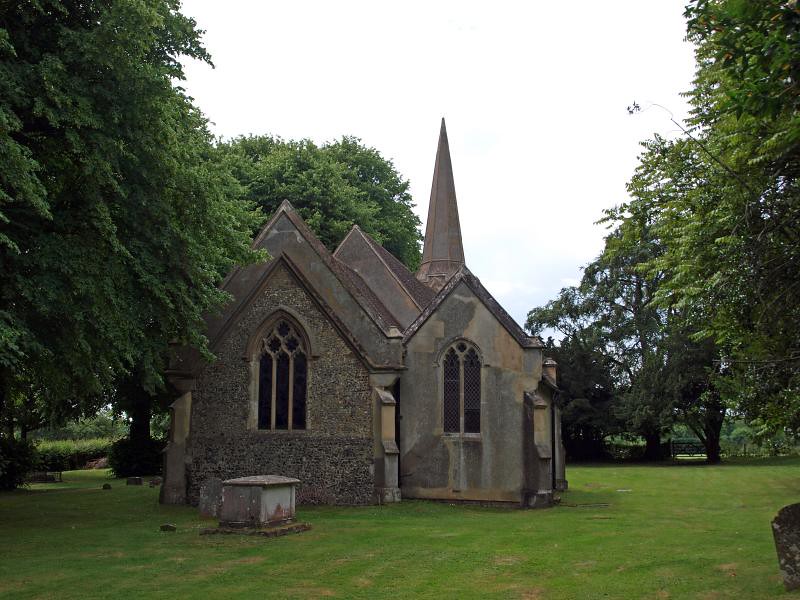ST ANDREW. So much restored in 1840 that it appears an Early Victorian building. The W tower is hardly taller than the nave roof and has a spire. The tower arch is characteristically thin and bodyless. - PLATE. Chalice, 1562; Paten, 1617; Breadholder, 1757. - MONUMENTS. Two epitaphs to George Viscount Grandison d. 1699 and the Rev. Edward Bourchier d. 1775, of identical design.
Bramfield. It has green verges by the wayside, an old well under a canopy on the green, one or two finely thatched cottages, a rectory with gables and dormers and clustered chimneys, and a church to which clings the memory of a famous man. We reach the church by a fine avenue of limes.
Thomas Becket’s name heads the list of rectors in the church. According to Matthew of Westminster, Bramfield was the first living of him whom we now know as St Thomas of Canterbury, and, though many a village in the 12th century never saw its rector, it is a moving thought that the voice once sternly raised against a king may have been here subdued to the service of a humble congregation. The church of his day was made new in the 13th century, and much restored 100 years ago, when the low tower and spire were built on the site of an old well. There are several 14th- and 15th-century windows, and old tie-beams with timbering above them. Over the beam between the nave and chancel is open arcading in stone. At the two sides of the porch are a man scratching his chin and a woman holding a cross and a rosary in her crossed hands. The chalice is Elizabethan, the chest is 17th century, and one of the two bells was made at the time Chaucer was writing his Canterbury Tales. One other reminder of the Bramfield rector whose murder at Canterbury set Chaucer’s pilgrims on their way is the pond in the rectory garden still known as Becket’s pond.
A mile or two away, on a hill by lovely woodlands, stands Queen Hoo Hall, still much as it was in Elizabeth I’s day. A tall house of red brick, patterned with blue on the front, it has clustered chimneys, mural paintings in an upper room, and mullioned windows from which is a magnificent view.
Thomas Becket’s name heads the list of rectors in the church. According to Matthew of Westminster, Bramfield was the first living of him whom we now know as St Thomas of Canterbury, and, though many a village in the 12th century never saw its rector, it is a moving thought that the voice once sternly raised against a king may have been here subdued to the service of a humble congregation. The church of his day was made new in the 13th century, and much restored 100 years ago, when the low tower and spire were built on the site of an old well. There are several 14th- and 15th-century windows, and old tie-beams with timbering above them. Over the beam between the nave and chancel is open arcading in stone. At the two sides of the porch are a man scratching his chin and a woman holding a cross and a rosary in her crossed hands. The chalice is Elizabethan, the chest is 17th century, and one of the two bells was made at the time Chaucer was writing his Canterbury Tales. One other reminder of the Bramfield rector whose murder at Canterbury set Chaucer’s pilgrims on their way is the pond in the rectory garden still known as Becket’s pond.
A mile or two away, on a hill by lovely woodlands, stands Queen Hoo Hall, still much as it was in Elizabeth I’s day. A tall house of red brick, patterned with blue on the front, it has clustered chimneys, mural paintings in an upper room, and mullioned windows from which is a magnificent view.

It's not that bad.
ReplyDeleteJust in case its locked status clouded my judgement I checked my notes and…… it is.
Delete